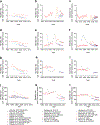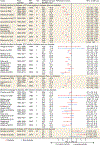A systematic review of trends in all-cause mortality among people with diabetes
- PMID: 32632526
- PMCID: PMC11000245
- DOI: 10.1007/s00125-020-05199-0
A systematic review of trends in all-cause mortality among people with diabetes
Abstract
Aims/hypothesis: We examined all-cause mortality trends in people with diabetes and compared them with trends among people without diabetes.
Methods: MEDLINE, EMBASE and CINAHL databases were searched for observational studies published from 1980 to 2019 reporting all-cause mortality rates across ≥2 time periods in people with diabetes. Mortality trends were examined by ethnicity, age and sex within comparable calendar periods.
Results: Of 30,295 abstracts screened, 35 studies were included, providing data on 69 separate ethnic-specific or sex-specific populations with diabetes since 1970. Overall, 43% (3/7), 53% (10/19) and 74% (32/43) of the populations studied had decreasing trends in all-cause mortality rates in people with diabetes in 1970-1989, 1990-1999 and 2000-2016, respectively. In 1990-1999 and 2000-2016, mortality rates declined in 75% (9/12) and 78% (28/36) of predominantly Europid populations, and in 14% (1/7) and 57% (4/7) of non-Europid populations, respectively. In 2000-2016, mortality rates declined in 33% (4/12), 65% (11/17), 88% (7/8) and 76% (16/21) of populations aged <40, 40-54, 55-69 and ≥70 years, respectively. Among the 33 populations with separate mortality data for those with and without diabetes, 60% (6/10) of the populations with diabetes in 1990-1999 and 58% (11/19) in 2000-2016 had an annual reduction in mortality rates that was similar to or greater than in those without diabetes.
Conclusions/interpretation: All-cause mortality has declined in the majority of predominantly Europid populations with diabetes since 2000, and the magnitude of annual mortality reduction matched or exceeded that observed in people without diabetes in nearly 60% of populations. Patterns of diabetes mortality remain uncertain in younger age groups and non-Europid populations.
Registration: PROSPERO registration ID CRD42019095974. Graphical abstract.
Keywords: Diabetes; Epidemiology; Mortality; Systematic review; Trends.
Figures



References
Publication types
MeSH terms
Grants and funding
LinkOut - more resources
Full Text Sources
Medical

